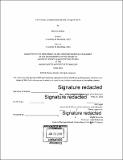Last Chance : crossing industrial and ecological cycles
Author(s)
Hutton, Monica (Monica Britt), 1987-
DownloadFull printable version (26.28Mb)
Alternative title
Crossing industrial and ecological cycles
Other Contributors
Massachusetts Institute of Technology. Department of Architecture.
Advisor
Rafi Segal.
Terms of use
Metadata
Show full item recordAbstract
Views of long-term environmental change often rely on linear narratives of growth and decline. Last chance sites have been described as offering a limited window of time to witness landscapes and seascapes that are deemed to exist within varying states of vanishing, captivating audiences with visible and timely sights of change. This thesis questions the agency of representing the future of these sites and calls for a strategy to look beyond end conditions to link less visible cycles with the roles of surrounding industry. On the coast of Hudson Bay, the self-declared "polar bear capital of the world" is discussed in relation to last chance sites due to an industry that has become reliant on visitors observing the changing environmental attractions of the area. This project examines how the northern town of Churchill, Manitoba developed at an intersection of migration between far reaching industrial and ecological systems. To the north the Arctic is opening with decreasing sea ice, and to the south an infrastructural rail line spurred the transformation of territory from a geographically concentrated urban population. Conceived of as a linear northern expansion project for future growth, the reality over time is a nonlinear emergence and decline of economic pursuits. The design strategy resists focusing on short-term development models by bringing public attention and cyclical activity to a broader territory. New linkages negotiate scattered and fluctuating industries such as forestry, mining, and energy production that support urban growth and a regional strategy focuses attention on overlooked sites, offering platforms to locate discourse on the role of development in longterm change across systems.
Description
Thesis: S.M. in Architecture Studies, Massachusetts Institute of Technology, Department of Architecture, 2018. Cataloged from PDF version of thesis. Includes bibliographical references (pages [132]-135).
Date issued
2018Department
Massachusetts Institute of Technology. Department of ArchitecturePublisher
Massachusetts Institute of Technology
Keywords
Architecture.